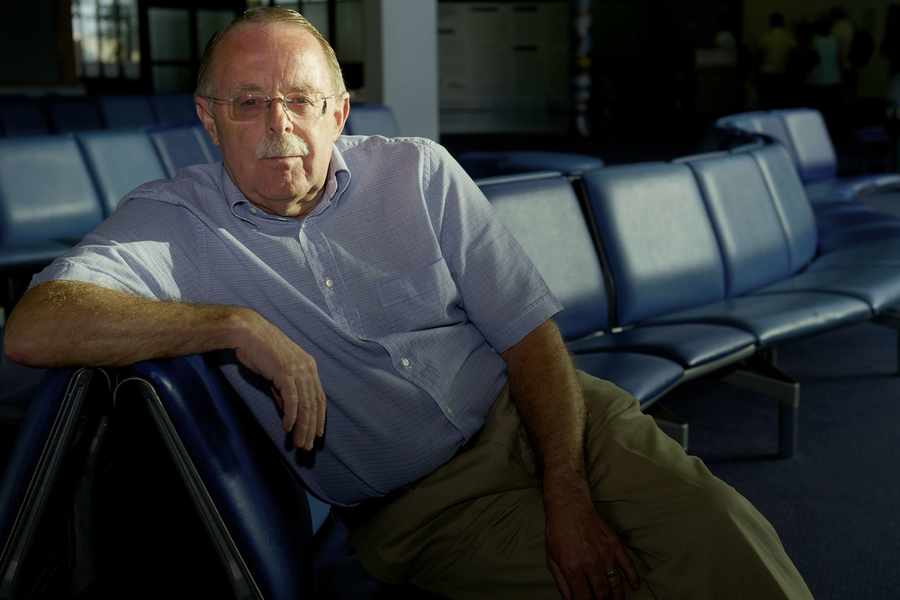Easter Monday 1995 was no different in that respect – except that this time the rumour was that a ship carrying more than 300 passengers was sinking.
On that day Jersey experienced its worst shipping disaster in modern times.
At around 10 am the Channiland St Malo fast ferry, which was travelling from Jersey to Sark, hit rocks at Corbière and began to send out frantic distress calls as it rapidly took on water.
A number of boats and helicopters came to the St Malo’s rescue, which ensured that there were no fatalities, although more than 50 people suffered injuries.
Twenty years later and the now retired former assistant chief ambulance officer vividly recounts his experiences at his St Clement home, where he received the emergency call on the day that put Jersey in the media spotlight around the world.
‘As soon as I got down to the Harbour, I was accosted by a guy who claimed to be a CNN reporter and he told me that they had a helicopter over the scene,’ Mr Connan said.
‘He wanted to know what was going on, but because it was offshore there was a distinct lack of information and even I didn’t know the full situation,’
‘There had been talk of an incident off St Malo and all sorts of weird and wonderful things. It was only a little while later that people appreciated it was the St Malo ship.
‘My role was to set up an emergency clearing station, and we were fortunate to have the terminal building to use, but at that time we had no idea of what was going to materialise.
‘The area of the Harbour where cars queue to get on to the ferry was cleared to become a helicopter landing zone and out of the blue a little French helicopter turned up with one casualty on board.
‘Eventually we started receiving casualties from two areas, with the lifeboat coming in with some casualties and one of the Condor fast ferries bringing in some people.’
Despite the makeshift nature of the emergency clearing zone and the rising number of injured passengers to deal with, the 63-year-old said that there was a sense of calm among the 30 staff at the terminal, who had practised possible emergency maritime scenarios on a number of occasions.
‘Once the phone call was made to ambulance headquarters, we clicked straight into our major incident plan.
‘I’ve been to scenes that were potentially major incidents but then they turned out not to be, and others that have seriously escalated. I think that you very much have to have an open mind when you go to these things.
‘We processed people through the station. I think there were about 52 people that we took into hospital and mainly through injuries jumping into the rafts. We had one chap who had a heart condition, but mainly we had people with sprained ankles, broken legs and injuries like that.’
Although the Channiland accident achieved international notoriety, it was not the first time that Mr Connan had responded to an incident that made global headlines.
Nine years before, he was part of the crew which was sent to Jersey Zoo after a five-year-old boy fell into the gorilla enclosure.
That day, Jambo – a male silverback gorilla – protected the boy from the other animals until he could be rescued.
‘It was another very unique experience, and so different from the St Malo crash,’ Mr Connan said.
‘I remember two zoo staff got into the compound and they were luring the gorillas away, back into their cages.
‘It was difficult for us because it wasn’t really safe to go in initially.
‘I lowered my colleague down and he treated the boy. He was unconscious but then he started screaming and people were around the compound getting anxious. Everyone applauded when the boy was plucked out of the pit. It was a very memorable day.’

Apart from these two high-profile events, Mr Connan says that it is the call-outs involving children, many of which were traumatic, that are most ingrained in his memory.
‘Years ago there was a French family on a yacht on the north coast and they had a minor fire on board. They all panicked and jumped into the sea in the complete dark.
‘The daughter, the son, the mother and their friend all drowned, and only the father survived. When we picked him up, he was telling me that he was swimming with his daughter and that she had slipped out of his arms and was gone.
‘A few years back I was watching a programme about the Titanic and there was a three-year-old boy who had drowned and somebody was recorded saying that a similar thing had happened – that the boy had slipped from their arms.
‘My wife turned to me and said: “You’ve gone ashen.” I remember being instantly taken back to the moment the man told me about his daughter.
‘I couldn’t get that out of my mind for a number of days. I never saw the little girl but the recollection of her father telling me was incredibly powerful.
‘These things, you deal with them, you park them, but sometimes they come back when you least expect them.’
Following his retirement six years ago, things are more relaxed for Mr Connan.
He now spends more time with Janet, his wife of 36 years, son Stuart and their two young grandchildren – through whom tales of grandad’s shipwreck emergencies and gorilla rescues will live on for years to come.






